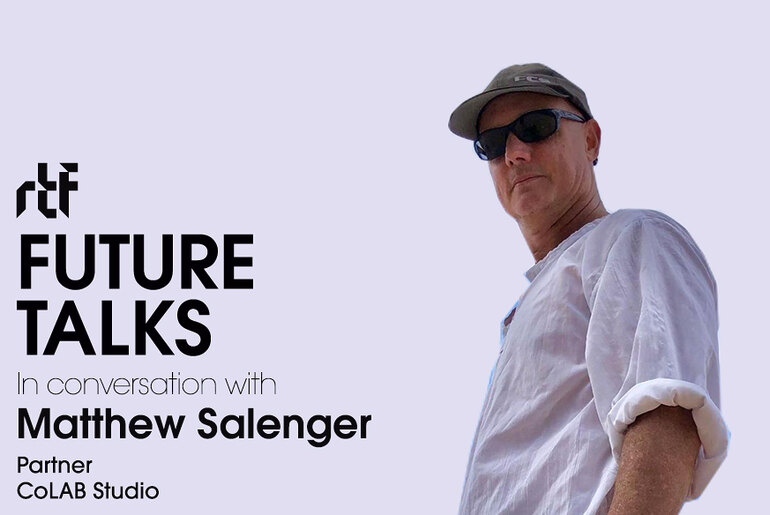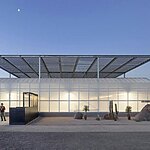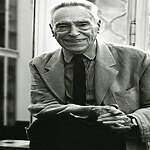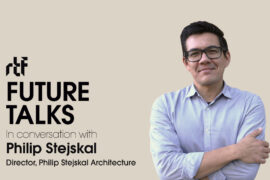Welcome to Future Talks by RTF, where we engage in enlightening conversations with visionaries who breathe life into design narratives. In our upcoming session, we have the privilege of delving into the world of Matthew Salenger—an artist, architect, and a true son of Maui. Matthew’s journey began with honors from Arizona State University in 1996, followed by prestigious recognition from The Architectural Association of London in 1999.
His unique perspective combines a passion for design, community interaction, and environmentalism, pushing the boundaries of what’s conceivable. Beyond his professional pursuits, Matthew is a lifelong surfer, musician, and non-fiction author. He has left an indelible mark as a co-founder and leader of various community organizations, including The Living Building Challenge Sonoran Collaborative, Urban Choices, Citizens for a Vibrant Apache Corridor, Southwest Regenerative Development Cohort, and the Phoenix Regenerative Development Group. Since 2019, Matthew has been immersed in the realm of Regenerative Practitioner, embodying a commitment to creating sustainable and regenerative solutions.
Join us as we unravel the insights and stories behind Matthew’s journey, shedding light on the intersection of art, architecture, and environmental stewardship.
RTF: Hi Matthew, We are glad to have you as a guest on Future Talks by RTF. Thanks for joining us. What does the balancing act of managing coLAB studio and the work you do with assisting communities within Phoenix, Arizona look like?
Matthew: When I was a college student, I believed the highest calling I could achieve was to build beautiful, lovable buildings for communities. But after my first 10 years of interning and practicing, I realized making interesting buildings was not bringing enough balance or satisfaction to my life. Buildings, on their own, rarely have a huge positive impact on communities. I started looking for other ways to use the skills and talents I had gained to make a more direct impact. Luckily, in 2012 I met a person who understood how and where I could make a difference.
In the first years I started to interact with people directly, I took on too many opportunities. I was volunteering with 4-5 different organizations at a time. The studio work suffered to some degree. To find a way to balance paid and unpaid work, coLAB studio eliminated the two full-time employees we had (finding great jobs for them elsewhere in the process), and started collaborating with external entities on an “as-needed” basis, which reduced overhead costs and management hours.
Since 2015 live-work balance has been easier. Plus, since our studio is on property we own, we have almost no overhead, which leaves a lot of time for volunteering and design experimentation.
RTF: Tell us about your architectural journey and what is your design advocacy.
Matthew: I grew up on the island of Maui, Hawai’i- at first a short walk from the amazing north shore with its rough surf, tidal pools, and (in the 1970s) empty beautiful beaches. During high school I lived “upcountry” at about 4300 ft elevation, within an eucalyptus and wattle forest in a tiny house clinging to the side of a deep gulch. In both locations, I was deeply attracted to the natural world, spending countless hours observing all the life around me.
When I was six years old I learned that human beings designed and built buildings (instead of buildings always existing on their own.) I immediately knew design is what I wanted to do.
I was also always interested in art. I was always drawing and making things. In college I studied both architecture and art. I took nearly 20 art studios, along with 13 architecture studios. I spent 10 years in college (including a gap year when I interned) which I never regretted. Plus I needed the time to mature. At first I floundered and didn’t get into “upper division” architecture. So I switched to art, where I flourished. When I returned to architecture I was able to connect the motivation I had for art studios with the desire to create impactful architecture. In the latter college years I had some great teachers and mentors, achieved accolades, and was able to intern with great architects such as Will Bruder, Eddie Jones (Jones Studio) and Götz Stöckmann (Formalhaut.)
I started working on coLAB studio full time just after my 35th birthday at the start of 2007. Most of the “architectural journey” from there was about learning how to collaborate on design with clients rather than designing something around them; and finding the tools to achieve that. I continue to study environmentalism, Integral Theory, sociology, and since 2019 Regenerative Development.
None of what coLAB studio has achieved would have been possible without my life and work partner, Maria Salenger. I constantly learn from, and lean on her. We have had a long journey together (28 years so far.) I try to tap into the love and respect Maria and I share with each other when working with clients.
Maria and I constantly work on public art projects to stay connected to art concepts. coLAB studio has as many public art projects as architecture works. We attempt to stay pure in both, and to knowingly insert concepts from each within the other. Art is our Yin, architecture our Yang.
Our “advocacy” work is a general way of describing volunteering efforts in various directions. For example: for 8 years I was the “head facilitator” of the Living Building Challenge Sonoran Collaborative, working to educate designers, clients, city officials, and others towards creating living buildings. I co-founded Citizens for a Vibrant Apache Corridor (CVAC), which works with developers, neighborhoods, and the city in the urban core of Tempe. I have also volunteered in the AIA Metro Phoenix’s Executive Committee and for the Roosevelt Row CDC Board. With the exception of the AIA, these opportunities allowed me to communicate big-picture issues and ideas directly to “lay-people,” who may have little knowledge of the building industry, on how to use their energy to create lasting positive change.
RTF: What are your challenges in overseeing almost every aspect of design in coLAB studio?
Matthew: The main challenge (beyond the volunteering vs work energy balance) is engaging the right team for each project, and ensuring quality. That is every architect’s main challenge: Making sure the ideas behind the work are clear when built and operating.
Also, finding projects is sometimes challenging, as it can be for any studio. We have been fortunate to get pulled into projects by clients seeking us- rather than us always seeking them. Though we do seek projects at times, particularly with public art. Our studio format of working with external consultants (rather than full-time in-house employees) is sometimes a challenge in that, with just the two of us, potential clients sometimes fail to see how a team full of top-tier professionals may provide better project quality, simply because it is a little different than a typical studio’s method.
RTF: What is your process of developing the initial thoughts about a project? How do you start?
Matthew: We never develop initial thoughts. We specifically try to eliminate preconceptions from our minds. We utilize the Integrative Design Process (IDP) to discover everything a project will require. Depending on the project, an IDP can last weeks or months- which sounds like a lot of work (and it is for the facilitator)- but it reduces overall project hours, conflicts, and risks.
RTF: What are your most rewarding projects and what makes them stand out?
Matthew: The first project that comes to mind is our ongoing work with the Desert Botanical Garden (DBG) in Phoenix, Arizona on their Hazel Hare Center for Plant Science; which started in 2014. This was the first project where we facilitated an Integrative Design Process. This IDP included 45 people discussing the project needs through a series of workshops. Every person that participated continue to tell me how the IDP provided so much knowledge, meaning, and excitement over the design process. The IDP experience alone made this one of our most rewarding projects- but the DBG is also a great client, and the buildings provide fun challenges. Phase one was completed in 2017, Phase two is under construction, with Phase three due in early 2026.
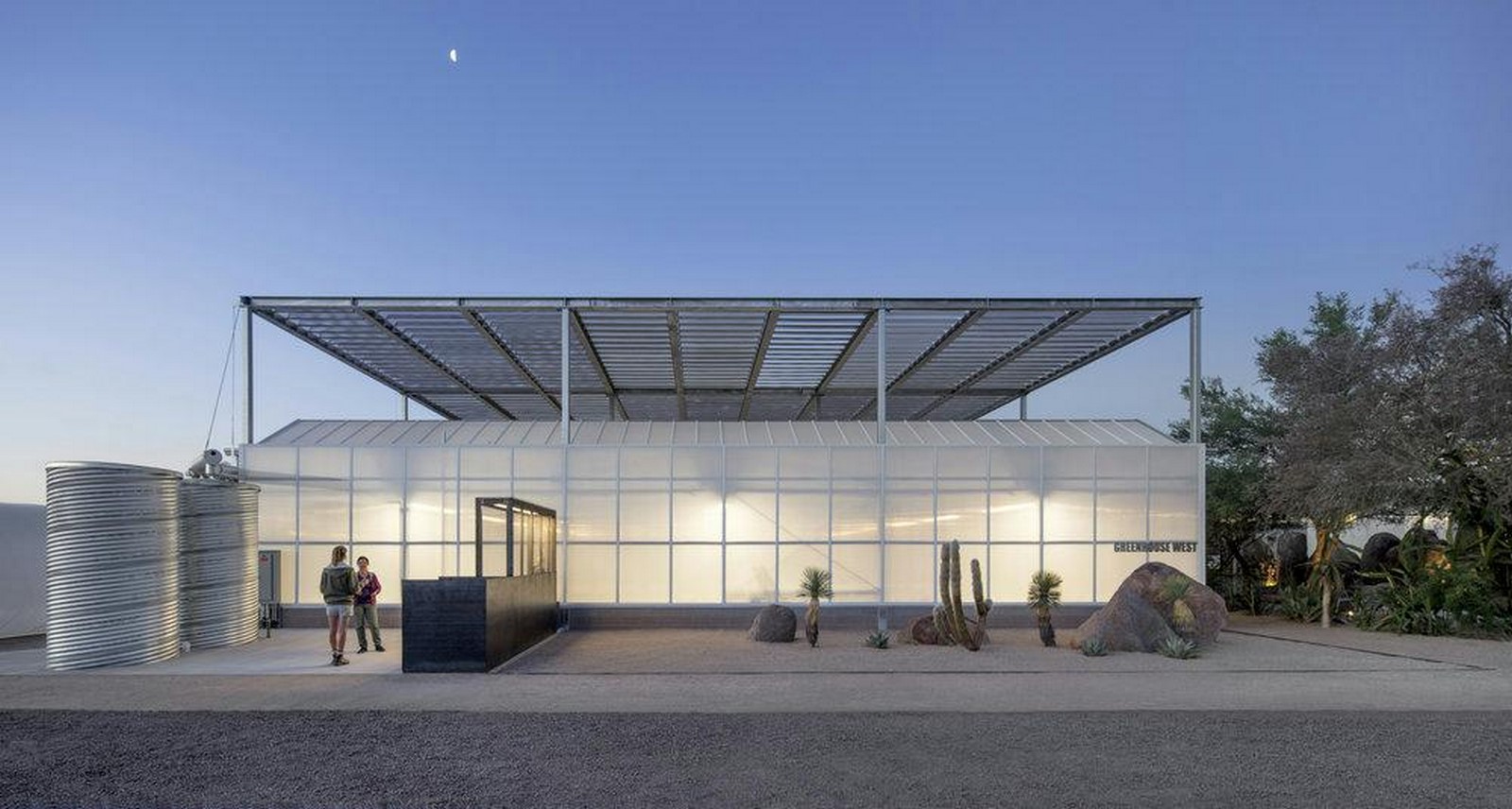
The second project that comes to mind is our recent public art installation at the new car-free development of Culdesac. I was asked to provide art-management to the site, vetting artists, providing contracts, locating art opportunities, and managing the entire public art process. I was also given the opportunity to provide a shade canopy to the development’s central plaza. I have been using public art opportunities to create more shade in the Phoenix Metro Area for ten years, so Culdesac’s project fit perfectly. The concept for the canopy, and the project title “Move Slow and Fix Things,” are among my favorites. Meeting and working with six other artists was also very rewarding.

RTF: What does your idea of scaling an architecture firm look like? What would you advise the young architects to build a successful architecture firm?
Matthew: Maria and I elected to forego full-time employees, and instead hire repeat top-tiered consultants on an as-needed basis for every project. This allows us to customize every design-team for each project. This provides clients the ability to work with companies and individuals with lots of experience, providing more unique environmental and design opportunities for our clients.
Another aspect this studio model provides is more opportunities for other businesses to thrive. For example, one of coLAB studio’s full-time employees we “let go” started their own studio, called Pattern Design Studio, whom we have worked with for more than a decade. Our studio supports his busy studio, and he continues to support us with quality services in a co-beneficial relationship.
Our volunteer work has also provided opportunities as we have been able to come into contact with people we would not have otherwise met. When people see qualities in Maria or I working for free in a volunteer position, it engenders a sense of trust from others. I was inspired to volunteer after reading a text by Paolo Soleri where he wrote that a person is not a complete human being without working towards someone else’s benefits while expecting nothing in return. I never expected to receive potential work because of volunteering- but indirect relationships can lead to real opportunities.
I would encourage young architects to find opportunities to use their skills outside of their regular work. Volunteer without expecting anything in return. Find something to feel strongly about, and go where the skills might provide the most benefit. Good things will come of it.
RTF: How do you look at the progression in the design and presentation of projects?
Matthew: Thinking of this question as our entire studio- not a particular project- I would say we constantly look for ways to increase our environmental awareness and building performance. We look for information and means to create higher performance. We track and present data to clients so they can make the most informed decisions on priorities. The aforementioned IDP process is critical in formulating the best design process and to present the best information. The IDP allows a constant flow of questioning and testing that allows us to progress designs with our team’s experience, knowledge, and the client’s input.
RTF: What are your views on working collaboratively with clients, consultants and contractors?
Matthew: We believe everyone involved with a project’s design is “essential,” which is made crystal clear through the Integrative Design Process (IDP.) If a project team is missing a piece, a piece of the project is lost.
RTF: What is your perspective on the evolving role of architectural criticism and the influence of architectural critics in the digital age?
Matthew: Honestly, I do not pay too much attention to architectural criticism, though I will provide some examples I appreciate. I used to read a lot of architectural criticism- but the more I work with communities, the more what I read seems out of touch with reality. Though truly thoughtful architectural critique comes and goes. Jane Jacobs is an example of someone that really understood the real-world impact of architecture from several decades ago. Jeff Speck is a more recent example in a similar vein. Aaron Betsky’s work is always interesting to read.
One particular essay on current culture and architecture I read recently is “The End of Manners; New Intolerances for the After-Post-Truth: Posthumanism, Precision, and Conservation” by Alejandro Zaera Polo. Alejandro’s article gives one a LOT to think about. I don’t agree with 100% of it, but the themes and conclusions continue to hang around with me.
RTF: How do you keep yourself motivated? What would you suggest to the budding architects who await success in the field? What must be the mindset?
Matthew: Motivation, or the Will to do something, comes from recognizing a gap that needs to be filled- a gap that calls for you to fill it. If you have no Will, chances are you aren’t looking hard enough or have not learned to see your relevant gaps yet. Sometimes my motivation comes from positive excitement about visualizing an opportunity. Sometimes it comes from frustration, from which we seek a positive outcome.
My suggestion to budding architects would be to identify a gap you feel needs to be filled. Fully examine it from all angles, including how you feel about the gap, why it calls to you, and what the inherent potential of filling the gap is. What has served us well is a simultaneous combination of emotional and intellectual investigation on a subject before acting upon it. Though, also, one should be self-conscious about over-personalizing anything. Being too personally close to anything can derail the best of plans.
And never stop learning. Particularly learning about things outside of what you may think of as architecture.
Thank you so much for doing this interview with us. It has been a pleasure getting to know about you and your work. We’re sure that your insights will be highly valuable to our audience which includes architects and design students.


